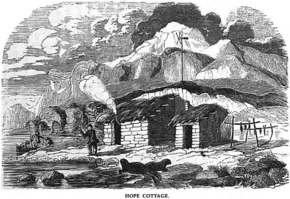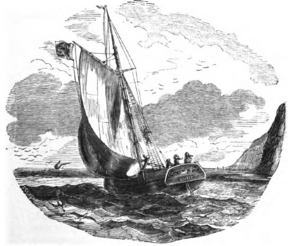John Nunn (sailor)
John Nunn ( July 2, 1803 , † after 1860) was an English seaman and author. During his time as a seaman he was shipwrecked on the uninhabited Kerguelen , which led to a three and a half year stay there. His experiences were later recorded in a book that described the seal hunt and, for the first time, the kerguelen in detail and which also has the character of a robinsonade .
Life
John Nunn was born on July 2, 1803 in Harwich , Essex , England , to a fisherman. In his early years he helped his father fish. At the age of 15 he began regular training and work on a turbot fishing trawler. Two years later he went to Holland and got hired on a fishing boat. He survived its sinking in heavy weather in the surf, went back to England and continued there as a fisherman on various boats.
At the beginning of 1825 he went to London because he wanted to gain more experience, and in April 1825 he was hired on the Royal Sovereign , whose aim was to catch seals on the then almost unknown and as now uninhabited Kerguelen in the sub-Antarctic Indian Ocean .
In August 1825, the end of winter in the southern hemisphere, the ship arrived at the Kerguelen, which was then also called the Island of Desolation or just Desolation . The crew began the hunt with a plan. Due to unfortunate events during an excursion by Nunn and three other crew members in December 1825, the Royal Sovereign left the Kerguelen without these four members of its crew, who remained on the Kerguelen surviving. It was not until the spring of 1828 that the crew of another ship found them and after a further year stay on the Kerguelen they were able to start their journey home with this ship, where they arrived in the summer of 1829.
Back in England, Nunn hired a mail ship for the continental mail service. In an accident, however, he soon lost two fingers on his right hand, so that he could no longer work as an able seaman. He therefore took a job on a pilot ship, which he held until 1837. After that he hired himself as a guide for visitors and with small fisheries in Harwich.
At the end of the 1840s, Nunn met WB Clarke, who found Nunn's stories about his experiences in the 1820s so remarkable that he wrote a book with him in which, on the one hand, Nunn's experiences chronologically, but also his geographical and scientific observations and craftsmanship Descriptions were recorded. In addition, the previously incomplete map series for the Kerguelen was completed and specified according to Nunn's information. In the summer of 1850, the book based on Nunn's memories was published. At the time, Nunn had a family, but was living in precarious circumstances, probably because of his crippled right hand, and was in need of support. Clarke therefore asked for Nunn's support in the preface to the book.
In the late 1860s, Nunn once again got into conversation with a visitor to Harwich, Richard Cuttler, about his earlier experiences in such a way that Cutler again presented Nunn and his experiences in a publication around 1870, albeit much shorter and in some cases contradicting the content of 1850 published book, so probably without knowledge of the same. At the time, Nunn lived on Church Street in Harwich.
Time on the Kerguelen
The Kerguelen are a strongly rugged, mountainous archipelago with many deeply cutting fjords , which extends over an area of about 130 * 130 km. It has a main island and countless other larger and smaller islands. There is a sub-Antarctic climate with often strong winds mainly from west to northwest . John Nunn and his three companions were on the Kerguelen from August 1825 to March 1829.
bad luck
The traditional seal-hunting operation required that a larger mother ship be safely anchored in a bay. Based on this, parts of the crew undertook longer - sometimes several weeks - excursions to various parts of the island in seaworthy dinghies, so-called sloops , in order to kill seals on their beaches and bring the prey - skins and bacon - back to the mother ship. The Royal Sovereign was anchored accordingly in Greenland Bay on the southeast side of the archipelago. Nunn took part in one of the excursions with the sloop Favorite to the west side of the archipelago. On December 26, 1825, the Favorite leaked and sank in the rocky waters of the island of Saddle Island (now Ile de Ouest ) off the west coast of the archipelago . The four crew members were able to save themselves and some equipment on the island. The mother ship could not find the excursion participants in a later search and therefore sailed back to England without them, so that the crew of the sunken Favorite stayed behind on Saddle Island .
Life on the Kerguelen
Life was full of privation because of the harsh climate and the scarce vegetation. At least fresh water was always plentiful. Seals, walruses, fish, ducks and all sorts of eggs were available as food. The walrus bacon ( blubber ) could be used as a roasting, lighting and heating means. The often icy temperatures, combined with inadequate and decaying equipment and clothing, made it difficult to hunt animals adequately, especially in the first winter.
The stranded spent the first months after the sinking of the Favorite on the very inhospitable Saddle Island. In the following months they were able to make a dinghy seaworthy and in the following summer (1826) they sailed to the less harsh east coast of the Kerguelen. They came to a small promontory on Long Point south of Cape Digby . There they were able to build a little hut, which they called "Hope Cottage". Together with the experience and skills they had gained, they were better equipped for the further perils of their island life.
A large part of the time the islanders had to spend on the procurement of food and the maintenance of equipment, namely clothing. In addition, excursions were made, partly on foot and partly with the available dinghy.
rescue
As part of their rescue strategy, the four islanders posted clues to their existence and whereabouts in various prominent locations in the Kerguelen Archipelago. In fact, this led to the fact that in March 1828 the crew of the cutter Lively found such a sign in Shallop Bay (now Baie Accessible ) and started the search. So the four were found in March 1828 and taken on board.
The Lively stayed with the enlarged crew and the larger mother ship, the schooner Sprightly , for another year for the planned hunting operation on the Kerguelen and left it at the end of March 1829. In the summer of 1829 the two ships reached England together with the found shipwrecked.
book
Nunn's experiences and observations during and around his three and a half year forced stay on the Kerguelen were published in the book published in 1850
- Narrative of the wreck of the "Favorite" on the island of Desolation:
- Detailing the adventures, sufferings, and privations of John Nunn
tells. WB Clarke is named as the publisher of the book. The book has 12 pages of foreword (vii - xviii) and 227 pages of content. It is decorated with a map of the Kerguelen and with various wood engravings made by Clarke's brother. The content of the work is undoubtedly by Nunn. However, it can be assumed that at least part of the paperwork was carried out by the editor or a representative.
The work describes maritime events such as regular seafaring, but also attempts at piracy. It also describes the regular fishing and hunting trades and the processing of the goods on site. A large part of the book, however, is the description of the four sailors' struggle for survival from December 1825 to March 1828. This goes hand in hand with descriptions of flora, fauna, geography, climate, nautical suitability and mineral resources (coal outcrops) of the Kerguelen, which Nunn described in great detail. He also described the phenomenon of countless killer whales swimming on the beach and dying there .
The Kerguelen map enclosed with the book has been improved and completed compared to earlier maps. However, it also has significant qualitative errors (such as the lack of isthmus at “Iceburgh Beach” on the south coast) and cannot always be reconciled even with Nunn's reports, the latter possibly only being due to confusion of names. The cardinal points of prominent structures are often clearly incorrect, which is perhaps due to the combined effects of deviation and the strong magnetic declination in this region , although the latter was already a numerically known phenomenon (around 1825 approx. −27 °). The deviations may also be due to the fact that the map was drawn from memory much later.
Since the Kerguelen were hardly known at that time and were rarely approached, the book is the first detailed representation of the archipelago. The book also draws a parallel to the well-known novel Robinson Crusoe by Daniel Defoe , which was published over a hundred years earlier (1719) . It is humorously noted that, unlike Robinson Crusoe, they didn't have a parasol, but would have liked to have had an umbrella.
The book was dedicated to the Cambridge botanist John Stevens Henslow , with whom Charles Darwin studied.
The book is available digitally through Google Books , but without the map.
gallery
See also
- Yves Joseph de Kerguelen de Trémarec
- Alexander Selkirk
- Subantarctic
- cartography
- List of Antarctic and Sub-Antarctic Islands
Individual evidence
- ↑ Not to be confused with the warship HMS Royal Sovereign of the same name, which was previously decommissioned
- ^ A b Narrative of the wreck of the "Favorite" on the island of Desolation: Detailing the adventures, sufferings, and privations of John Nunn by John Nunn and WB Clarke, 1850, on Google Books, here as .pdf
- ↑ An Historical and Archaeological Sketch of the Ancient Town, HARWICH, by a visitor at Dovercourt , by Richard Cutler, 1870.
- ↑ Harwich Papers - An anthology of material relating to Harwich, mostly from original sources, which has not already appeared in print by Leonard T. Weaver, 1994.
| personal data | |
|---|---|
| SURNAME | Well, John |
| BRIEF DESCRIPTION | English sailor and author |
| DATE OF BIRTH | July 2, 1803 |
| DATE OF DEATH | after 1860 |










